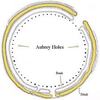History of Architecture Flashcards
(84 cards)
A prehistoric monument consisting of an upright megalith, usually standing alone but sometimes aligned with others.
Menhir - Long stones


Rudston Monolith
the talles menhir in the UK

The Geant du Manio
a 6.5m menhir in France

Head Statues, Easter island
Rapa Nui
A heap of stones pile up as a monument, tombstone or landmark.
Cairn, Carn


maen ceti (arthur stone)

Cairnholy

Clava Cairns
Feature Page on Undiscovered Scotland
An artificial mound or earth or stone, esp over an ancient grave.
Tumulus, Barrow


Central Section of crescent-shaped monument at Lajuad W Sahara
A prehistoric monument consisting of two or more large upright stones, supporting a horizontal stone slab, foundesp in Britain and France and usually regard as a tomb.
Dolmen


Poulnabrone Dolmen

Dolmen | Dolmen in Steinfeld/Germany (ca. 2000-2500
A megalithic tomb of the neolithic and early bronze ages found in the British Isles and Europe, consisting of a roof burial chamber and narrow entrance passage, covered by Tumulus.
Passage Grave, Chamber Grave, Galler Grave


Hunebed, Passage grave

A simple passage tomb in Carrowmore near Sligo in Ireland
Located at the southern part of Salisbury Plain, about 8 miles north of Salisbury, 2 miles west of Avebury.
The focal point of the densest concentration of Neolithic and Bronze Age
Undergone in 4 period of building and use
Used from c 30000 BCE until after 1100 BCE
Stonehenge

AD means
anno Domini[a][1][2] (AD) and before Christ[b][3][4][5] (BC)
AD meaning “the year of Christ”
Stonehenge Phase 1
c3000 BCE
About 91m across
Ditch and bank, work began c2800 BCE
Probably a place of Neolithic astronommical observations, worship, and burials for about 7 centuries

Discovered by John Aubrey
Aubrey Holes 17C
Never held upright posts
unknown purposes
treated wit hchalks
the holes were immediately refilled
reused for burials of cremated human bones.
Aubrey Holes

Stonehenge 2
Introduction of a new axis, a more east than previous one
addition of the Avenue (510m)
addition of the Bluestones

The probable builders of Stonehenge II
Early Bronze Age (c2000 - 1500 BC) people buries around Stonehenge because of the pottery beakers found in graves.
Beaker People
Stonehenge 3-A
2000 BC
Composed of 30 upright stones in uniform height capped by a horizontal ring of stone lintels.






































